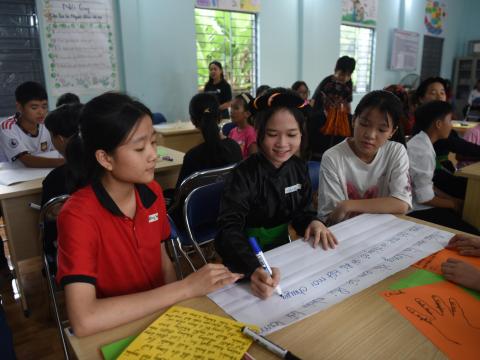For a brighter and prosperous East Asia, we must invest in empowering girls

Written by Mona Stella Mariano, Asia-Pacific Regional Advisor for Gender Equality and Social Inclusion, World Vision International
East Asia, a region of incredible diversity, faces a unique set of challenges. It's a place where booming economic development coexists with vulnerabilities increasingly driven by natural hazards, socio-economic instability, climate-induced disaster and the consequent migration trends. The impacts are felt by all, but the disturbing reality is how these challenges are borne disproportionately by girls.
The International Day of the Girl Child serves as a poignant reminder of the uphill battle that girls face. It shines a light on the enduring gender disparities that girls endure. But beyond just highlighting these issues, it's rallying for action.
A complex tangle
Climate change and migration are two sides of the same coin, and the consequences ripple far and wide. According to a UNICEF report, The Children’s Climate Risk Index (CCRI) is rated extremely high for Myanmar, and high for Cambodia, Laos, Thailand, China, Viet Nam and Democratic People’s Republic of Korea. In East Asia, a region accustomed to extreme weather events like typhoons and floods, climate change often leaves the harshest impacts on girls. Its impact is compounded by poverty, limited access to basic resources and inadequate infrastructure.
When natural hazards thwart livelihoods and compromise food security, they turn into short-term or protracted displacement. This either results in children being left behind as their parents leave their hometown in search of work opportunities or pushes them into migration alongside their parents to a place unknown.
With the former scenario, studies in China show that these children, especially girls and the younger ones, are more likely to fall ill or develop chronic diseases (Q. Li, Liu, and Zang 2015). Studies in Vietnam also find that girls tend to shoulder more household responsibilities (Lam 2019) and fed with less food compared to boys (Graham and Jordan 2013), resulting in stunted growth. In Cambodia, girls may be forced into early marriage to manage the risks posed by disaster impacts (Polack 2010).
With the latter scenario, gender and age would often play a significant role and a shaping factor in determining the vulnerabilities and risks that girls face. For instance, employers in Thailand often prefer Lao women as domestic workers, creating an influx of female and young girl migrants from Laos, Cambodia and Myanmar. There is also the dark side of exposing girls to the sinister world of sex trafficking (Molland 2011).
Empowering girls as agents of change
World Vision recognises the barriers young women and girls face due to gender inequalities, hindering their development and opportunities. We are committed to amplifying the voices of girls and young women in their families and communities, empowering them to become catalysts for positive and sustainable change.
In East Asia where entrenched gender roles persist, we strive to address discrimination and violence against girls, with a focus on promoting girls' education and decision-making capabilities.
We engage with children and youth to build positive and equitable norms and relationships in their families and communities. We empower both girls and boys to advocate for equality as well as provide focus on girls’ education, which protects them against child marriage, pregnancy and domestic violence.
We also strive to amplify the voices of girls, partner with community leaders and communities to address negative norms and practices like forced marriage and engage men and boys in promoting gender equality within their relationships. We work to nurture safe school environments with adequate feeding and nutrition services.
Alongside formal education, we provide girls with informal learning opportunities which build up girls’ life skills and relationships while increasing their confidence to contribute to solutions to the issues that they face in their communities.
Through our multi-sectoral approach, World Vision has impacted the lives of over 1.7 million girls in East Asia.
On this International Day of the Girl Child, let's celebrate the potential of East Asian girls and their invaluable contributions in their families and communities. But let's not stop at celebration; let's take action together to empower girls and promote gender equality. By doing so, we can ensure that girls in East Asia can experience well-being and become the agents of positive change in their communities and beyond.
References:
Li, Qiang, Gordon Liu, and Wenbin Zang. 2015. “The Health of Left-behind Children in Rural China.” China Economic Review 36 (December): 367–76. https://doi.org/10.1016/j.chieco.2015.04.004.
Lam, Theodora. 2019. “Young Women and Girls Left behind. Causes and Consequences.” In Supporting Brighter Futures. Young Women and Girls and Labour Migration in South-East Asia and the Pacific, 11–28. International Organization of Migration.
Graham, Elspeth, and Lucy P. Jordan. 2013. “Does Having a Migrant Parent Reduce the Risk of Undernutrition for Children Who Stay behind in South-East Asia?” Asian and Pacific Migration Journal 22 (3): 315–47.
Polack, Emily. 2010. “Child Rights and Climate Change Adaptation: Voices from Kenya and Cambodia.” Institute of Development Studies and Plan International. https://resourcecentre.savethechildren.net/document/child-rights-and-climate-change-adaptation-voices-kenya-and-cambodia/
Molland, Sverre. 2011. “The Trafficking of Scarce Elite Commodities: Social Change and Commodification of Virginity along the Mekong.” The Asia Pacific Journal of Anthropology 12 (2): 129–45.